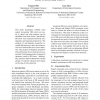Free Online Productivity Tools
i2Speak
i2Symbol
i2OCR
iTex2Img
iWeb2Print
iWeb2Shot
i2Type
iPdf2Split
iPdf2Merge
i2Bopomofo
i2Arabic
i2Style
i2Image
i2PDF
iLatex2Rtf
Sci2ools
NAACL
2007
2007
Are Some Speech Recognition Errors Easier to Detect than Others?
This study investigates whether some speech recognition (SR) errors are easier to detect and what patterns can be identified from those errors. Specifically, SR errors were examined from both nonlinguistic and linguistic perspectives. The analyses of non-linguistic properties revealed that high error ratios and consecutive errors lowered the ease of error detection. The analyses of linguistic properties showed that ease of error detection was associated with changing parts-of-speech of reference words in SR errors. Additionally, syntactic relations themselves and the change of syntactic relations had impact on the ease of error detection.
| Added | 30 Oct 2010 |
| Updated | 30 Oct 2010 |
| Type | Conference |
| Year | 2007 |
| Where | NAACL |
| Authors | Yongmei Shi, Lina Zhou |
Comments (0)

